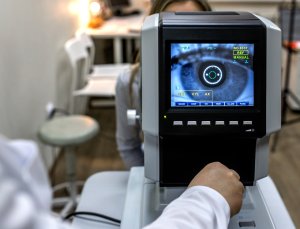Retinal Detachment Surgery

Voted Best of Berks—
eight years in a row!
The retina is located in the back of the eye and works somewhat like film in a camera, sending messages to the brain about what we see. When something happens to cause a tear or retinal detachment, surgery may be required to prevent vision loss.
Eye Consultants of Pennsylvania is the leading full-service ophthalmic and ophthalmology practice in Berks County, Pennsylvania. Our board certified, fellowship-trained vitreo-retinal team, Barry C. Malloy, MD, Michael Cusick, MD, and Anastasia Traband, MD, have extensive experience in retinal detachment surgery. They will evaluate your symptoms and consult with you about the latest state-of-the-art technology and treatments for retinal tears and detached retinas.
Barry C. Malloy, MD, is board-certified and completed his vitreo-retinal fellowship training at the Washington Hospital Center. He specializes in cutting-edge treatments for detached retinas, including the use of intraocular injections and surgical tools for complex retinal detachment repair.
Michael Cusick, MD, is board-certified and completed a medical and surgical vitreo-retinal fellowship at the Duke Eye Center. He specializes in vitreo-retinal disorders, including retinal detachment, macular holes, diabetic retinopathy and other conditions of the retina and vitreous.
Anastasia Traband, MD, is board-certified and completed her vitreo-retinal fellowship at the Sheie Eye Institute at the Penn Medicine Hospital at the University of Pennsylvania after receiving her medical degree at Jefferson Medical College in Philadelphia. She specializes in vitreo-retinal disorders, including retinal detachment, macular holes, diabetic retinopathy and other conditions of the retina and vitreous.
What is the Retina?
The retina is the light-sensitive tissue that lines the back of the eye. It usually lies smoothly and firmly against the back wall of the eye. Light rays enter the eye through the cornea, pupil, and lens and are sharply focused on the retina. Working somewhat like film in a camera, the retina records the light signals and transmits them to the brain via the optic nerve. The brain interprets the signals and converts them to images to tell us what we are looking at.
What is a Detached Retina?
When the retina is exceptionally thin or becomes damaged, fluid may cause all or part of it to separate or “detach” from the tissue at the back of the eye. The detached part of the retina can no longer accurately transmit light signals to the brain, and vision becomes blurred. In most cases, a detached retina occurs only in one eye.
Retinal detachment is a medical emergency. Although it is a treatable condition, it must be taken care of immediately, or it can cause vision loss and, in the worst cases, blindness.
What are the Symptoms of a Detached Retina?
Most people describe a detached retina as a gray curtain that moves down over the field of vision. This occurs after detachment has already begun. There are, however, some signs or symptoms that may be signs that the retina is about to detach:
- Large increase of eye floaters in your field of vision
- Sudden, brief flashes of light in the eye
- Sudden onset of blurry vision
- Shadows or blind spots in your peripheral vision
If you experience any of these symptoms, it’s important to see an ophthalmologist right away. They may be signs of retinal detachment or another serious eye condition, and prompt treatment may prevent you from losing vision.
How is Retinal Detachment Treated?
Depending upon the severity of your retinal tear or detachment, there are several different procedures that can be done to try to repair the problem, including:
- Laser surgery: Laser surgery may help to repair tears in the retina that are causing the retinal separation.
- Cryopexy (freezing): This procedure applies extreme cold to the tissue around the hole or tear. It causes a scar to develop which can hold the retina in place.
- Pneumatic retinoplexy: A tiny bubble of gas is placed in the eye to push the retina back into place. This is often accompanied by laser surgery to ensure that the retina stays in the right position permanently.
- Scleral buckling: A silicone “buckle” (tiny bands of silicone rubber) can be sutured to the white of the eye (sclera). This indents the wall of the eye into a position that allows the retina to reattach.
- Vitrectomy: If necessary, the vitreous gel can be removed and a gas bubble can be injected to push the retina back against the wall of the eye and hold it in position.
Today, many patients can be successfully treated with retinal detachment surgery. The best results occur when treatment is started early. Make an appointment with Eye Consultants of Pennsylvania at the first sign of trouble. We have five convenient locations in Wyomissing, Pottsville, Pottstown, Lebanon and Blandon.
For an appointment, call toll-free 1-800-762-7132.
Find a Doctor
Physician information including education, training, practice location and more.
Schedule an Appointment
Call 800-762-7132 or make an appointment online.





